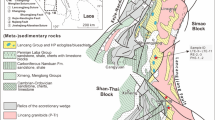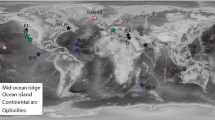Abstract
Since the publication of the paper of , loss on ignition (LOI) has been widely used as a method to estimate the amount of organic matter and carbonate mineral content (and indirectly of organic and inorganic carbon) in sediments. The relationships between LOI at 550 °C (LOI550) and organic carbon (OC) content and between LOI at 950 °C (LOI950) and inorganic carbon (IC) content are currently accepted as a standard. However, the comparison of 150 analyses of samples of diverse lithologies, collected from a single core, reveals that these relationships are affected by sediment composition (presence of clays, salts, and the variable content of organic carbon). This results in an incremental error on the estimation of carbon content from LOI values that invalidates the use of LOI values as a quantitative method for estimating carbon content. Conversely, the general trends of LOI550 and LOI950 show a good correlation with carbon content (both organic and inorganic) allowing use of LOI as a qualitative test for carbon content. Similarly, in our case, LOI at 105 °C (LOI105) is a good qualitative proxy for the trends in gypsum content.
Similar content being viewed by others
References
Battarbee R.W., Grytnes J.A., Thompson R., Appleby P.G., Catalan J., Korhola A., Birks H.J.B., Heegaard E.and Lami A.2002.Comparing palaeolimnological and instrumental evidence of climate change for remote mountain lakes over the last 200 years.J.Paleolim.28:161–179.
Beaudoin A.2003. A comparison of two methods for estimating the organic matter content of sediments.J.Paleolim.29: 387–390.
Bendell-Young L.I., Thomas Ch.A.and Stecko J.R.P.2002. Contrasting the geochemistry of oxic sediments across eco-systems:a synthesis.Appl.Geochem.17:1563–1582.
Boyle J.F.2001. Inorganic geochemical methods in palaeolimnology.In:Last W.M.and Smol J.P.(eds),Tracking Environmental Changes Using Lake Sediments,vol.vn2,Physical and Geochemical Methods.Developments in Paleoenvironmental Research.Kluwer Academic Publishers, Dordrecht, The Netherlands,pp.83–141.
Boyle J.F.2004. A comparison of two methods for estimating the organic matter content of sediments.J.Paleolim.31:125–127.
Bengtsson L.and Enell M.1986. Chemical analysis.In:Berglund B.E.(ed.),Handbook of Holocene Palaeoecology and Palaeohydrology.John Wiley & Sons Ltd, Chichester, pp.423–451.
Brauer A., Mingram J., Frank U., Gu ¨nter Ch., Schettler G., Wulf S., Zolitschka B.and Negendank J.F.W.2000. Abrupts environmental oscillations during the Early Weichselian recorded at Lago Grande di Monticchio,southern Italy.Quat. Int.73:(74):79–90.
Brindley G.W.and LeMaitre J.1987. Thermal,oxidation and reduction reactions of clay minerals.In:Newman A.C.D. (ed.),Chemistry of Clays and Clay Minerals.Mineralogical Society Monograph,6.Longman & Scienti c Technical, Essex,pp.319–370.
Dean W.E.1974. Determination of carbonate and organic matter in calcareous sediments and sedimentary rocks by loss on ignition:comparison with other methods.J.Sed.Petrol. 44:242–248.
Dean W.E.1999. The carbon cycle and biogeochemical dynamics in lake sediments.J.Paleolim.21:375–393.
Dodson J.R.and Ramrath A.2001. An Upper Pliocene lacustrine environmental record from south-Western Australia - preliminary results.Palaeogeogr.Palaeoclim.Palaeoecol. 167:309–320.
Grunsky E.C.2001. A program for computing RQ-mode principal components analysis for S-PLUS and R.Comp. Geosci.27:229–235.
Heiri O., Lotter A.F.and Lemcke G.2001. Loss on ignition as a method for estimating organic and carbonate content in sediments:reproducibility and comparability of results.J.Paleolim.25:101–110.
Ihaka R.and Gentleman R.1996. R:A language for data analysis and graphics.J.Comp.Graph.Stat.5:299–314.
Korsman T., Nilsson M.B., Landgren K.and Renberg I.1999. Spatial variability in surface sediment composition characterisec by near-infrared (NIR)re.ectance spectroscopy.J.Paleolim.21:61–71.
Lebreton J.D., Sabatier R., Banco G.and Bacou A.M.1991. Principal component and correspondence analyses with respect to instrumental variables:an overview of their role in studies of structure-activity and species-environment relationships.In:Devillers J.and Karcher W.(eds),Applied Multivariate Analysis in SAR and Environmental Studies. Kluwer Academic Publishers, Dordrecht,The Netherlands, pp.85–114.
Meyers P.A.and Lallier-Verges E.1999. Lacustrine sedimentary organic matter records of Late Quaternary paleoclimates.J.Paleolim.21:345–372.
Meyers P.A.and Teranes J.L.2001. Sediment organic matter. In:Last W.M.and Smol J.P.(eds),Tracking Environmental Change Using Lake Sediments.Vol.2:Physical and Geo-chemical Methods.Kluwer Academic Publishers, Dordrecht, pp.239–269.
Ralska-Jasiewiczowa M.,Rózański K., Wacnik A., Czernik J.and Chrüst L.2003. Very fast environmental changes at the Pleistocene/Holocene boundary,recorded in laminated sediments of Lake Gości aż,Poland.Palaeogeogr.Palaeoclim.Palaeoecol.193:225–247.
Ramrath A., Zolitschka B., Wulf S.and Negendank J.F.W. 1999. Late Pleistocene climate variations as recorded in two Italian maar lakes (Lago di Mezzano,Lago Grande di Monticchio).Quat.Sci.Rev.18:977–992.
Ran Y., Fu J.M., Sheng G.Y., Beckett R.and Hart B.T.2000. ractionation of colloidal and suspended particulate materials in rivers.Chemosphere41:33–43.
Rosen M.R., Chague ´-Go. C., Eser P.and Coshell L.2002. Utilisation of the sedimentological and hydrochemical dynamics of the Stump Bay Wetland along Lake Taupo,New Zealand,for the recognition of paleo-shoreline indicators. Sed.Geol.148:357–371.
Stecko J.R.P.and Bendell-Young L.I.2000. Contrasting the geochemistry of suspended particulate matter and deposited sediments within an estuary.Appl.Geochem.15:753–775.
Valero-Garce ´s B.L., Gonza ´lez-Sampe ´riz P., Delgado-Huertas A., Navas A., Machý ´n J.and Kelts K.2000. Lateglacial and Late Holocene environmental and vegetational change in Salada Mediana,central Ebro Basin,Spain.Quat.Int.73: (74):29–46.
Author information
Authors and Affiliations
Rights and permissions
About this article
Cite this article
Santisteban, J.I., Mediavilla, R., López-Pamo, E. et al. Loss on ignition: a qualitative or quantitative method for organic matter and carbonate mineral content in sediments?. Journal of Paleolimnology 32, 287–299 (2004). https://doi.org/10.1023/B:JOPL.0000042999.30131.5b
Issue Date:
DOI: https://doi.org/10.1023/B:JOPL.0000042999.30131.5b




